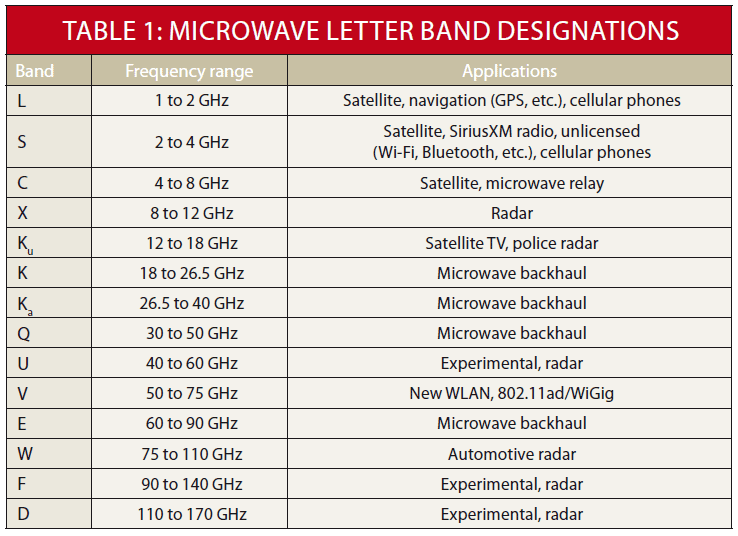The microwave frequency range is an essential aspect of modern technology, encompassing various applications that affect our daily lives. It plays a crucial role in communication systems, cooking technologies, and scientific research. As we delve deeper into this frequency range, we uncover the underlying principles that govern its operation and the innovations that stem from it.
Microwaves are defined by their wavelengths, which typically fall between one millimeter and one meter, corresponding to frequencies ranging from 300 MHz to 300 GHz. This frequency range is significant for various applications, including radar systems, satellite communications, and even household microwave ovens. Understanding the nuances of the microwave frequency range allows us to appreciate its impact on technology and our everyday lives.
As we explore the microwave frequency range, we will delve into its characteristics, applications, and the science behind it. The importance of this frequency range cannot be overstated, as it serves as the backbone for many technological advancements. Join us as we unravel the intricacies of microwaves and their vital role in shaping our world.
What is the Microwave Frequency Range?
The microwave frequency range generally spans frequencies from 300 MHz to 300 GHz. Within this range, microwaves can be classified into different bands, such as:
- UHF (Ultra High Frequency): 300 MHz to 3 GHz
- SHF (Super High Frequency): 3 GHz to 30 GHz
- EHF (Extremely High Frequency): 30 GHz to 300 GHz
Each of these bands has distinct properties and applications. For example, UHF is commonly used in television broadcasting and mobile communications, while SHF is essential for radar and satellite communications. EHF is primarily used in advanced research applications and high-frequency data transmission.
How Do Microwaves Work?
Microwaves operate based on the principles of electromagnetic radiation. When a microwave signal is transmitted, it travels through space at the speed of light and interacts with materials it encounters. The interaction between microwaves and matter results in various effects, including heating and reflection.
In microwave ovens, for instance, microwaves penetrate food and excite water molecules, causing them to vibrate and generate heat. This process cooks the food evenly and efficiently. Similarly, in radar systems, microwaves are used to detect objects by bouncing signals off them and analyzing the reflected waves.
What Are the Applications of the Microwave Frequency Range?
Microwaves have a wide range of applications across various fields, including:
- Communication: Microwaves are widely used in satellite communications, mobile networks, and radio broadcasting. Their ability to transmit data over long distances makes them invaluable in modern communication systems.
- Cooking: Household microwave ovens utilize microwaves to cook food quickly and efficiently, revolutionizing meal preparation.
- Radar Technology: Microwaves play a critical role in radar systems used for air traffic control, weather monitoring, and military applications.
- Medical Applications: Microwaves are used in various medical treatments, such as diathermy, which involves using microwave energy to generate heat in tissues for therapeutic purposes.
What Are the Benefits of Microwave Technology?
The microwave frequency range offers numerous benefits, including:
- Efficiency: Microwaves provide rapid heating and cooking, saving time and energy.
- Versatility: The diverse applications of microwaves make them useful in various industries, from telecommunications to healthcare.
- Non-Invasive: In medical applications, microwaves can be used for non-invasive treatments, reducing recovery times and minimizing discomfort.
Are There Any Limitations to Microwave Technology?
Despite their advantages, microwave technology also has some limitations. These include:
- Line-of-Sight Communication: Microwaves require a clear line of sight for effective transmission, making them less effective in obstructed environments.
- Interference: Microwaves can be susceptible to interference from other electronic devices, which can affect signal quality.
- Health Concerns: While the use of microwaves is generally safe, there are concerns about potential health risks associated with prolonged exposure to microwave radiation.
What Future Innovations Can We Expect in Microwave Technology?
As technology continues to advance, we can expect several innovations in the microwave frequency range:
- Improved Communication Systems: The development of higher frequency bands and advanced modulation techniques will enhance data transmission speeds and reliability.
- Enhanced Medical Applications: Research into microwave-based therapies may lead to new treatments for various medical conditions.
- Smart Appliances: The integration of microwave technology into smart home appliances will further improve convenience and efficiency.
Conclusion: Embracing the Microwave Frequency Range
The microwave frequency range is a vital component of modern technology, with applications that span communication, cooking, and medicine. Understanding the characteristics and benefits of microwaves helps us appreciate their impact on our daily lives. As we look toward the future, continued advancements in microwave technology promise to enhance our world further, making it essential for us to stay informed and embrace these innovations.
You Might Also Like
Nose Piercing: A Deep Dive Into Its Meaning And Cultural SignificanceExploring The Universe Of Marvel Wiccan Comics
Transforming Ink: The Art And Meaning Behind The Cover Of Tattoo
Understanding The Microwave Frequency Range: Applications And Characteristics
Embracing Growth: A Guide On How To Mature
Article Recommendations
- Zin Manga
- Wanya Morris
- Andy Bassich
- Sabrina Carpenter Weight Height
- Vanessa Trump
- Joan Van Ark
- Toby Keiths Car Collection
- Deepfake Voice Kpop
- Cancer Weekly Horoscope
- Corey Harrison


